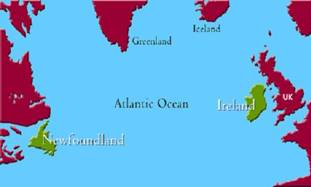|
|
||||||||||||||||||||||
| Special Relationship with Newfoundland | |||||||||||||||||||||||
The island of Newfoundland is located in the Gulf of St. Lawrence and the larger Labrador portion is on the eastern part of the Canadian mainland. Newfoundland and Labrador is Canada's most easterly province and it’s newest, having joined the Confederation in 1949. The province has a population of just over 500,000, spread over a large area of land (405,720 sq. km.), almost five times the size of Ireland. Slightly more than half the people live in small fishing villages strung along the rocky and rugged coastline. The remainder lives in cities and towns, the largest of which is the provincial capital of St. John's. The economy of the province rests heavily on the exploitation of natural resources, a fact that is reflected in family and community life. The population of Newfoundland and Labrador came mostly from the south and southeast of Ireland and the southwest of England. Many Newfoundland names are directly linked to their Irish roots, with names like Byrne, Cahill, Doyle, Hogan, Walsh, and Whalen. You can visit the Newfoundland and Labrador tourism website at: www.gov.nf.ca/tourism/ The Ireland Newfoundland Partnership (I.N.P.) was created following an initiative taken, at Taoiseach and Premier level, to mark the historic links between Ireland and Newfoundland. The Governments of Ireland and Newfoundland signed a Memorandum of Understanding in 1996. An Taoiseach Bertie Ahern and Premier Danny Williams reaffirmed the memorandum in 1999 and again in July 2004. Considerable contacts have been made and a number of business, education and cultural groups have already carried out projects in the partner country.
|
|||||||||||||||||||||||
 |
|||||||||||||||||||||||
| Did you know? | |||||||||||||||||||||||
|
|||||||||||||||||||||||


